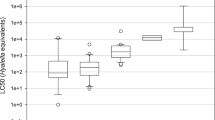Abstract
Eighteen organochlorine pesticides (OCPs) were studied to develop species sensitivity distributions (SSDs) and calculate hazardous concentration thresholds for 5% of species (HC5), using both parametric (log-normal and log-logistic) and nonparametric bootstrap methods. In order to avoid picking repetitive values in each resample when performing bootstrap, and to determine the influence of fluctuation of toxicity data of single species on the SSDs and HC5, a modified bootstrap method was introduced, which can generate unrepetitive sampling data other than original elements in datasets. This method can enlarge a dataset without any assumption of a special distribution. Combined with parametric methods, modified bootstrap was also used to develop SSDs and determine HC5. The HC5 estimated by five approaches coincide well with each other with good positive correlation. Even if there is intra-species variation in a certain range of toxicity data; SSDs and HC5 are not very sensitive to the local fluctuation of toxicity of single species. The studied OCPs were classified according to their estimated HC5. A lower HC5 indicates higher ecological toxicity potentials. Endrin, DDTs and Endosulfan are OCPs with very high ecological toxicity potential. α-HCH has the lowest ecological toxicity potential in the studied OCPs. For OCPs with high ecological potential, more attention should be paid to their ecological risk.





Similar content being viewed by others
References
Chen CS (2005) Ecological risk assessment for aquatic species exposed to contaminants in Keelung River, Taiwan. Chemosphere 61:1142–1158
Duboudin C, Ciffroy P, Magaud H (2004) Acute-to-chronic species sensitivity distribution extrapolation. Environ Toxicol Chem 23(7):1774–1785
González-Doncel M, Ortiz J, Izquierdo JJ, Martín B, Sánchez P, Tarazona JV (2006) Statistical evaluation of chronic toxicity data on aquatic organisms for the hazard identification: the chemicals toxicity distribution approach. Chemosphere 63:835–844
Grist EPM, Leung KMY, Wheeler JR, Crane M (2002) Better bootstrap estimation of hazardous concentration thresholds for aquatic assemblages. Environ Toxicol Chem 21(7):1515–1524
Grist EPM, O’Hagan A, Crane M, Sorokin N, Sims I, Whitehouse P (2006) Bayesian and time-independent species sensitivity distributions for risk assessment of chemicals. Environ Sci Technol 40(1):395–401
Hoeven NVD (2001) Estimating the 5-percentile of the species sensitivity distributions without any assumptions about the distribution. Ecotoxicology 10:25–34
Jagoe RH, Newman MC (1997) Bootstrap estimation of community NOEC values. Ecotoxicology 6:293–306
Jones KC, Voogt PD (1999) Persistent organic pollutants (POPs): state of the science. Environ Pollut 100:209–221
Kenaga EE (1982) Predictability of chronic toxicity of chemicals in fish and aquatic invertebrates. Environ Toxicol Chem 1:347–358
Li YF, Cai DJ, Singh A (1999) Historical DDT use trend in China and usage data gridding with 1/4° by 1/6° longitude/latitude resolution. Adv Environ Res 2:497–506
Li YF, Cai DJ, Shan ZJ, Zhu ZL (2001) Gridded usage inventories of technical hexachlorocyclohexane and lindane for China with 1/6° latitude by 1/4° longitude resolution. Arch Environ Contam Toxicol 41:261–266
Newman MC, Ownby DR, Mézin LCA, Powell DC, Christensen TRL, Lerberg SB, Anderson BA (2000) Applying species sensitivity distributions in ecological risk assessment: assumptions of distribution type and sufficient number of species. Environ Toxicol Chem 19:508–515
OSPAR (2005) Cut-off values for the selection criteria of the OSPAR dynamic selection and prioritisation mechanism for hazardous substances. OSPAR 05/21/1-E, Annex 7
Pennington DW (2003) Extrapolating ecotoxicological measures from small data sets. Ecotoxicol Environ Saf 56:238–250
Qiu XH, Zhu T, Yao B, Hu JX, Hu SW (2005) Contribution of dicofol to the current DDT pollution in China. Environ Sci Technol 39:4385–4390
Roex EWM, van Gestel CAM, van Wezel AP, van Straalen NM (2000) Ratios between acute aquatic toxicity and effects on population growth rates in relation to toxicant mode of action. Environ Toxicol Chem 19(3):685–693
Shao QX (2000) Estimation for hazardous concentrations based on NOEC toxicity data: an alternative approach. Environmetrics 11(5):583–595
Sijm D, Hulzebos E, Peijnenburg W (1999) Estimating the PTB-profile. RIVM report 601503 016
UNEP-Chemicals (2004) Stockholm convention on persistent organic pollutants, United Nation Environment Programme. Available from: http://www.pops.int/. Accessed on 15/10/2007
USEPA (1998) Guidelines for ecological risk assessment. EPA/630/R-95/002F
Wang XL, Tao S, Dawson RW, Xu FL (2002) Characterizing and comparing risks of polycyclic aromatic hydrocarbons in a Tianjin wastewater irrigated area. Environ Res 90:201–206
Wang B, Yu G, Yu YJ, Zhamg ZL, Hu HY, Wang LS (2006) Aquatic ecological risk assessment of OCPs in Huaihe River, Jiangsu section. Chin J Geochem 25(suppl.):157
Wheeler JR, Grist EPM, Leung KMY, Morritt D, Crane M (2002) Species sensitivity distributions: data and model choice. Mar Pollut Bull 45:192–202
Wiandt S, Poremski HJ (2002) Selection and prioritisation procedure of hazardous substances for the marine environment within OSPAR/DYNAMEC. Ecotoxicology 11:393–399
Yu G, Niu JF, Huang J (2005) Persistent organic pollutants—new global environmental problem (in Chinese). Science Press, Beijing
Zolezzi M, Cattaneo C, Tarazona JV (2005) Probabilistic ecological risk assessment of 1,2,4-trichlorobenzene at a former industrial contaminated site. Environ Sci Technol 39:2920–2926
Acknowledgement
This research was supported by the National Basic Research Program (973) of China (Grant No. 2003CB415007).
Author information
Authors and Affiliations
Corresponding author
Rights and permissions
About this article
Cite this article
Wang, B., Yu, G., Huang, J. et al. Development of species sensitivity distributions and estimation of HC5 of organochlorine pesticides with five statistical approaches. Ecotoxicology 17, 716–724 (2008). https://doi.org/10.1007/s10646-008-0220-2
Received:
Accepted:
Published:
Issue Date:
DOI: https://doi.org/10.1007/s10646-008-0220-2




